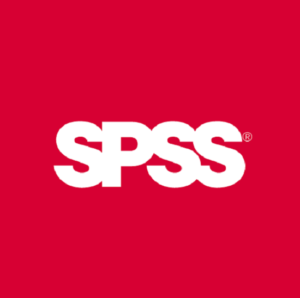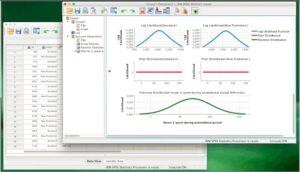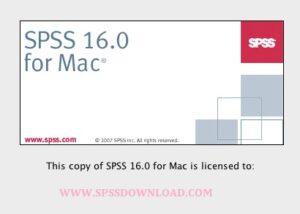why Spss uses what is the main feature of Spss statistics
SPSS is a widely used program for statistical analysis in the social sciences. It is also used by market researchers, health researchers, survey companies, government, education researchers, marketing organizations, data miners, and others. The original SPSS manual (Nie, Bent & Hull, 1970) has been described as one of the “most influential books in sociology” that allows ordinary researchers to conduct their own statistical analyzes. In addition to statistical analysis, data management (case selection, file reshaping, creation of derived data) and data documentation (a dictionary of metadata is stored in the data file) are features of the core software.
SPSS Statistics Features
The many functions of SPSS Statistics can be accessed through drop-down menus or can be programmed with a proprietary command syntax language 4GL. Command syntax programming offers the benefits of reproducible output, simplifies repetitive tasks, and handles complex data analysis and manipulation. Also, some complex applications can only be programmed in syntax and are not accessible through the menu structure. The drop-down menu interface also generates command syntax, which can be seen in the output, although the default must be changed to make the syntax visible to the user. They can also be pasted into a syntax file using the “paste” button present in each menu. Programs can be run interactively or silently, using the provided production job functionality.
Additionally, a “macro” language can be used to write command language subroutines. A Python programmability extension can access information in the data and data dictionary and dynamically create command syntax programs. The Python Programmability Extension, introduced in SPSS 14, has replaced the less functional SAX Basic “scripts” for most purposes, although SaxBasic is still available. Additionally, the Python extension allows SPSS to run any statistics in the free software package R. As of version 14, SPSS can be managed externally by a Python or VB.NET program using the provided “plugins”. (Starting with version 20, these two scripting features, as well as many scripts, are included on the installation media and are typically installed by default.)
SPSS Statistics
SPSS Statistics places restrictions on internal file structure, data types, data processing, and corresponding files, which together greatly simplify programming. SPSS data sets have a two-dimensional table structure, where the rows generally represent cases (such as individuals or families) and the columns represent measures (such as age, gender, or household income). Only two types of data are defined: numeric and text (or “string”). All data processing is done sequentially on a case-by-case basis through the file (dataset). Files can be matched one to one and one to many, but not many to many. In addition to this structure and processing of cases by variables, there is a separate Matrix session where the data can be processed as matrices using linear and matrix algebra operations.
What is a graphical user interface
The graphical user interface has two views that can be changed by clicking one of the two tabs at the bottom left of the SPSS Statistics window. The “Data View” shows a spreadsheet view of cases (rows) and variables (columns). Unlike spreadsheets, data cells can only contain numbers or text, and formulas cannot be stored in these cells. The ‘Variables View’ shows the metadata dictionary where each row represents a variable and shows the variable name, variable label, value label, print width, measure type, and a variety of other features. Cells in both views can be edited manually, defining the file structure and allowing data entry without using command syntax.
This may be sufficient for small data sets. Larger data sets, such as statistical surveys, are often created in data entry software or entered during personal computer-assisted interviews, scanning and using OCR and OCR software, or through direct acquisition of online questionnaires. These data sets are then read into SPSS.
SPSS Statistics can read and write data from ASCII text files (including hierarchical files), other packages
Versions and ownership history
Data Collect Wikipedia
The software was first released in 1968 as a Social Science Statistical Package (SPSS) after being developed by Norman H. Nie, Dale H. Bent, and C. Hadlai Hull. These directors were incorporated as SPSS Inc. in 1975. Early versions of SPSS Statistics were written in Fortran and designed for mainframe batch processing, including, for example, the IBM and ICL versions, which originally used punch cards. for entering data and programs. A render run reads an SPSS command script file and a raw fixed-format data input file with a single record type or “get file” of data saved from a previous run. To save valuable time on your computer, you can perform a “change” to check command syntax without parsing the data. Starting with version 10 (SPSS-X) of 1983, data files can contain various types of records.
Prior to SPSS 16.0, several versions of SPSS were available for Windows, Mac OS X, and Unix.
SPSS Statistics version 13.0 for Mac OS X was not compatible with Intel-based Macintosh computers, due to the Rosetta emulation software causing miscalculations. SPSS Statistics 15.0 for Windows required the installation of a downloadable patch to be compatible with Windows Vista.
Starting with version 16.0, the same version works on Windows, Mac, and Linux. The graphical user interface is written in Java. The Mac OS version is provided as a universal binary, making it fully compatible with both PowerPC and Intel-based Mac hardware.
SPSS Inc announced on July 28, 2009, that it would be acquired by IBM for $ 1.2 billion. Due to a dispute over ownership of the name “SPSS”, between 2009 and 2010, the product was named PASW (Predictive Analytics SoftWare). In January 2010 it became “SPSS: An IBM Company”. The complete transfer of the business to IBM took place on October 1, 2010. As of that date, SPSS: An IBM company has ceased to exist. IBM SPSS is now fully integrated into IBM Corporation and is one of the brands in the IBM Software Group business analytics portfolio, along with IBM Algorithmics, IBM Cognos, and IBM OpenPages.
Complementary software of the “IBM SPSS” family is used for data mining and text analysis (IBM SPSS Modeler) and for real-time credit assessment services (IBM SPSS Collaboration and Deployment Services).
SPSS Data Collection and SPSS Dimensions were sold in 2015 to UNICOM Systems, Inc., a division of UNICOM Global, and merged into the integrated UNICOM Intelligence software package (survey design, survey implementation, data collection, data management, and relationships).
What is the SPSS software used for?
SPSS is a widely used program for statistical analysis in the social sciences. It is also usually used by market researchers, survey companies, health researchers, government, education researchers, marketing organizations, data miners, and others.
What is SPSS and how does it work?
SPSS is short for Statistical Package for Social Sciences and is used by various types of researchers for complex statistical analyzes. The SPSS software package was created for the statistical analysis and management of social science data.
What are SPSS and its advantages?
One of the benefits of SPSS is that students can import data from other sources, when the data is organized like a database, including Excel.
Importing an Excel spreadsheet into SPSS for data analysis is a fairly straightforward process, requiring some preparation and some basic steps.
What are the features of SPSS?
SPSS is software for editing and analyzing all types of data. This data can come from virtually any source – scientific research, a customer database, Google Analytics, or even a website’s server log files.
SPSS can open all commonly used file formats for structured data such as
spreadsheets from MS Excel or OpenOffice;
- plain text file (.txt or .csv);
- relational databases (SQL);
- State and SAS.
Is SPSS free for students?
IBM SPSS is commercially available, copyrighted software, and is not freely available. As a student or staff member, you may have access to SPSS through your university at no cost to you.



